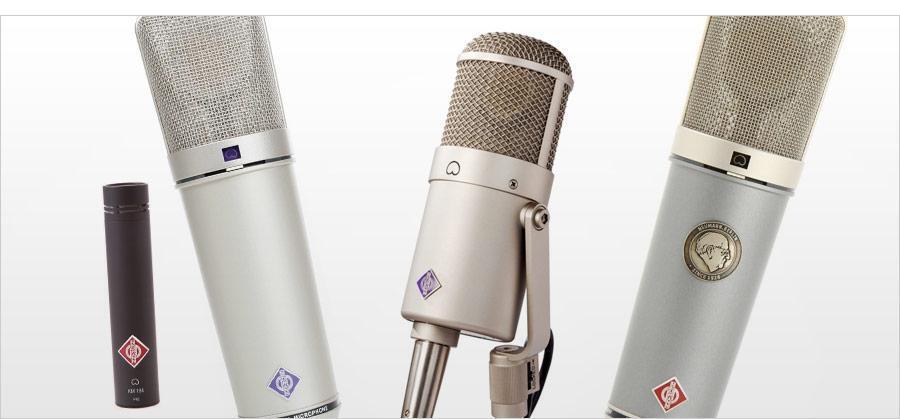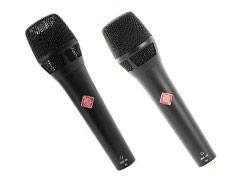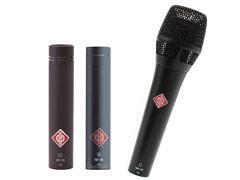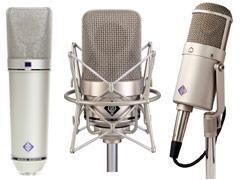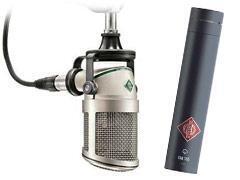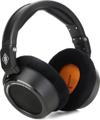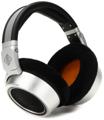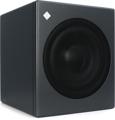Neumann Microphones
With almost a century of microphone innovations to their name, every Neumann microphone is designed to be outstanding in one audio application or another. For every audio task, there’s a mic that’s right for the job, but with so many options, how do you decide which one? Selecting a Neumann microphone is an outstanding start for any recording project, and Sweetwater has created this buying guide to help you find the best Neumann microphones for your applications.
Which Neumann Mic Fits My Application?
Engineers at Sweetwater know that picking which mic sounds “best” on any given source is largely subjective. Regardless of your application, you can expect Neumann mics to serve up wide-ranging sound with excellent detail, low noise, and exceptional depth. Each Neumann mic has its own characteristics that help it stand out in particular applications, whether you need high SPL handling, vintage tube warmth, or a radio-ready vocal sound. Read on to find the most popular Neumann microphones for common studio and live sound applications.
Live Vocals
For vocalists performing in the Sweetwater Performance Theatre, we choose handheld vocal microphones with high gain before feedback, excellent off-axis rejection, physical durability, and low handling noise. The Neumann KMS 105 and KMS 104 handheld condenser microphones exceed our expectations for all of these requirements, and they sound amazingly sweet and smooth too. The capsule is internally shockmounted and does an exceptional job of rejecting handling noise and taming plosives as well.
So what’s the difference between the KMS 105 and KMS 104? The KMS 105 has a tighter supercardioid pickup pattern, for the best front-to-back sound rejection. The KMS 104 has a wider cardioid pickup pattern, for the best rear sound rejection. If the mic is positioned on a mic stand in front of a floor monitor speaker, the cardioid pattern often gives the best results. For handheld applications or singers who move around the stage a lot, the supercardioid pattern is a smart choice.
Popular Neumann Mics for Live Vocals:
- KMS 105 – Studio-quality vocal sound, supercardioid polar pattern for best front-to-back sound rejection
- KMS 104 – Same outstanding sound quality, with cardioid polar pattern for best rear sound rejection
Studio Vocals
When recording vocals in the studio, you aren’t concerned with things such as handling noise or gain before feedback – you just want the absolute best vocal sound you can capture. While every vocalist is different, Neumann microphones have proven themselves time and time again to serve up world-class vocal recordings. Whether you’re after vintage tube warmth or maximum clarity and detail, there’s a Neumann mic that will exceed your expectations.
Leveraging Neumann’s acclaimed transformerless circuitry, the TLM 107 is a versatile multi-pattern condenser that’s particularly loved for the transparent way it handles vocals. A 2-stage highpass filter lets you tailor its response to a wide range of registers. Similarly, the TLM 107’s 2-stage pad accommodates everyone from the most intimately quite vocalists to singers who pack seriously powerful projection.
For a rich, vibrant vocal sound, it’s hard to beat a Neumann tube condenser mic like the M 149. This is the sound that engineers talk about when discussing the sweet sound of vintage tube mics. With switchable polar patterns and a variable low-cut filter, the M 149 is a true studio workhorse.
To capture sweet vocals without the enhanced harmonics of a tube mic, the Neumann TLM 49 transformerless condenser microphone is an outstanding choice. With a wide-ranging response and consistent tone across the dynamic range, this mic is a great choice for capturing expressive performances with clarity and detail.
Home studios and project studios on a budget can tap into the exceptional sound quality of Neumann microphones with the TLM 102 large-diaphragm condenser. This compact mic boasts low-noise circuitry and uncolored sound that’s a great solution for vocals and dialogue.
Popular Neumann Mics for Studio Vocals:
- TLM 107 – Phenomenal transparancy, flexible configuration options
- M 149 – Vintage tube warmth, heard on countless major label recordings
- TLM 49 – Modern, well-balanced tone at all SPL levels, excellent for dynamic singers
- TLM 102 – Low noise, wide response, and transparent sound make this a great value
Live Instruments
If you’re trying to capture delicate acoustic instruments onstage, you’ll want mics with excellent side rejection and a clear, defined sound with a wide frequency response. Live sound engineers have long turned to the KM 184 and KM 185 small-diaphragm condenser mics for instruments on stage including acoustic guitar, percussion, and brass. Their clean sound and exceptional dynamic range make getting a great live sound easy.
The KM 184 has a cardioid polar pattern for the best rear sound rejection, while the KM 185 has a supercardioid pattern for the best side sound rejection. Which you choose depends on the mic’s position in relation to other sound sources (like amplifiers and stage monitors), but you can expect the same outstanding sound quality from both models.
And even though we’ve mentioned the KMS 105 as a live vocal solution, its wide, balanced response and excellent noise rejection make it a solid contender for instruments too. Its handheld design makes it a natural choice for singers, but expect great results on acoustic guitar or percussion too.
Popular Neumann Mics for Live Instruments:
- KM 184 – Transparent sound and extremely high SPL handling, cardioid polar pattern for the best rear sound rejection
- KM 185 – Same sound qualities as KM 184, supercardioid pattern for better front-to-rear sound rejection
- KMS 105 – Extremely clear sound, with superb transient detail suitable for acoustic guitars and percussion
Studio Instruments
When you’re recording in your studio, you need to make sure you’re capturing the full dynamic range of your instruments, and of course, you want clear sound with as little noise as possible. For an all-around studio workhorse that’s just as capable as a drum overhead pair as it is on electric guitar amplifiers or hand percussion, the U 87 Ai is a smart choice. It’s the modern version of the legendary U 87, and its high SPL handling makes it ideal for capturing loud sources with clarity.
When you’re after that larger-than-life quality, the M 150 tube condenser microphone is a sweet choice. The omni polar pattern is perfect for capturing every acoustic detail in any room, and the transient response is amazing. Put it in a well-treated acoustic space, and you’re ready to capture exceptionally vibrant, lifelike recordings.
Neumann has also re-created their classic U47 FET condenser microphone with the U47 FET Collector’s Edition, known among engineers as one of the top kick drum microphones of all time. It earned that reputation thanks to high SPL handling, consistent sound across the entire dynamic range, and extraordinary transient response. These characteristics also make it a great choice for bass instruments, percussion, and even some vocalists.
When the original U 47 tube mic went off the market in 1960, it left a serious vacuum in its wake. Neumann addressed this with the release of its successor, the U 67. While it shared many common characteristics with its predecessor, the EF86 pentode tube that replaced the discontinued VF14 at the heart of the ’47 gave this new mic a special vibe that quickly made it a staple of the recording industry. The U 67 practically defined the sound of the ’60s, and with its return to the market, you too can benefit from this amazing mic.
Popular Neumann Mics for Studio Instruments:
- U 87 Ai – High SPL handling and clear, present sound are perfect for drum overheads
- M 150 – Rich tube character, huge dynamic range, wide-open sound, and superb transient detail
- U 47 FET Collector’s Edition– Legendary kick drum, percussiong, and bass mic
- U 67 – Classic tube mic, amazing headroom, brings out the life in guitar cabs, drums, and more
Broadcast and Film Production
For a radio-ready vocal sound, just speak into the Neumann BCM 705. It’s Neumann’s first dynamic microphone and boasts low noise, rich sound, and a highly focused hypercardioid polar pattern. It’s also designed to reduce mechanical noise and handling noise when you’re adjusting the mic during broadcast.
Neumann’s KM 185 is a solid choice for recording foley or location sound to be used in post production. The sound is clear and well balanced, and its compact size and focused pickup pattern are practical for a mobile recording rig.
Popular Neumann Mics for Broadcast and Film Production:
- BCM 705 – Big, radio-ready sound, with excellent rejection of mechanical or handling noise
- KM 185 – Small size, tight polar pattern, and clear sound make this ideal for foley and location recording
This guide should help point you in the right direction when it comes to choosing a Neumann microphone for a specific purpose. In a perfect world, you’d have unlimited time and resources to audition every microphone possible for any given application. In the real world, when time is of the essence, you can expect solid results in these applications with these recommended mics. If you ever have questions about Neumann microphones or microphone accessories, just contact your Sweetwater Sales Engineer.
What Do Neumann’s Badge Colors Indicate?
You’ll notice that every Neumann microphone proudly displays the Neumann badge, but you’ll also notice a variety of badge colors. What do they mean? The badge color identifies the type of internal signal path utilized by that microphone. Neumann has developed a number of different microphone designs over the years, and the badge color tells you which design your microphone uses.
Black: Tube
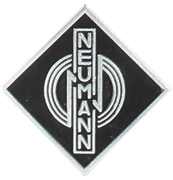
You’ll find the black diamond on Neumann’s tube microphones such as the legendary U47, M49, and U67. The tube amplifier stage can add complex harmonics that enhance the overall richness of your recording. When engineers talk about warm, vintage tone, it’s often a classic tube microphone they’re describing.
Purple: FET 80 + Transformer
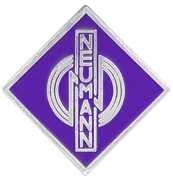
As solid-state microphone technology advanced, Neumann created mics with a FET amp stage with an output transformer. FET-based mics don’t generate the additional harmonic content that tubes can, resulting in “cleaner” recordings with more precise sound. This design also allows for smaller overall size than tube microphones require.
Red: FET 100 + No Transformer
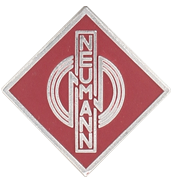
Neumann’s transformerless microphones employ a FET amp stage, with a transformerless output circuit that reduces self noise and can make the microphone’s overall response more accurate. While recording engineers love the character of transformer-based mics, there are many applications in which the additional transparency and accuracy of a transformerless mic are desired.
Blue: Digital
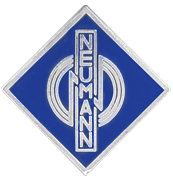
Neumann was the first microphone manufacturer to develop mics with a digital output stage, designated by the blue badge. These mics employ an A/D converter and DSP processor directly after the mic capsule, with an AES 42 digital output that allows for very long cable runs with no additional noise. Neumann’s digital microphones boast amazing dynamic range and fidelity, making them a top choice for orchestral recordings.
Green: Dynamic
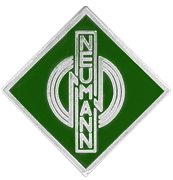
With so many famous condenser microphones to their name, it’s easy to forget that Neumann makes an exceptional dynamic microphone that’s widely used in broadcast. The BCM 705 dynamic mic captures radio-ready sound with the exceptional ruggedness and SPL handling you look for in a dynamic microphone.


